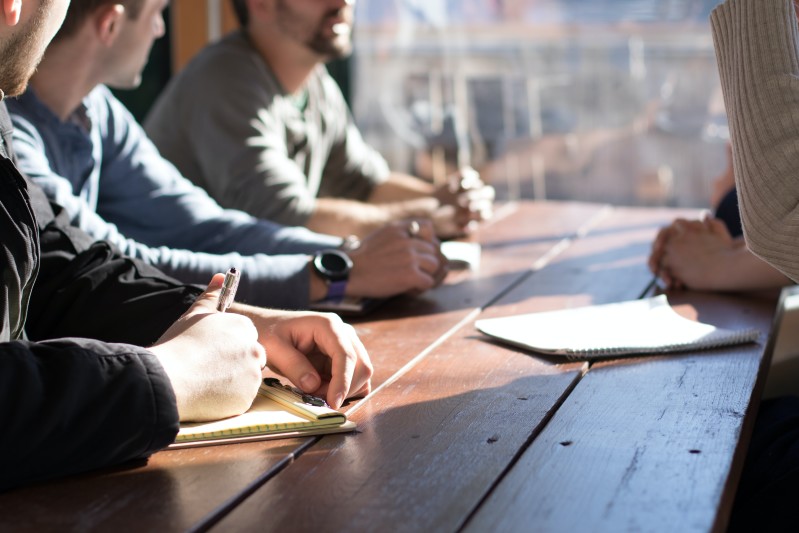
Working from home is a bit of a double-edged sword.
On the one hand, you get to skip the commute, avoid the crowds, cook up a storm for lunch if you want to.

On the other, working remotely — whether from home or a shared office space — can make teamwork a lot tougher than it needs to be.
When you can’t be in a room with your team to read their body language or simply run an idea by them, everything becomes much more complicated.
But it doesn’t have to be this way.
With the right tools and strategies, your team can start making smart, reasoned decisions as a group — no matter where you are in the world.
If you’ve just started working remotely and you’re wondering how your team will ever reach a consensus, this one’s for you.
The problem with remote team decision-making
Before we dig into the solution to the problem, let’s first examine the challenges you might face as a remote worker in a team based around the globe.
Imagine that you’re based in New York City, and you’re placed in a team with members in London, Berlin, Moscow, and Seoul.

That’s quite a geographic spread.
And while this wide range of viewpoints will certainly be beneficial to the end result, this level of physical disconnection can cause a few hiccups.
And it’s not just about geographical distance — the simple physical disconnection can be enough to make this problematic even for teams in the same time-zone.
Here are just a handful of the problems you may encounter when trying to make a decision as a decentralized team:
Disparate schedules make conversations asynchronous.
If you’ve ever tried to organize a group trip, you’ll know how frustrating it can be when everyone responds at a different pace.
Without a real-time connection to others in the group — for example, when you’re only using email and responding as-and-when you can — making a group decision can become excruciating.

This added sense of latency essentially makes your conversations asynchronous, and that is not conducive to great team decision-making.
Failing to properly consider all of the options.
When remote groups come together to try to solve a problem, it’s easy to rush to a resolution — after all, time is of the essence when you’ve got everyone together from different time zones.
What this means, however, is that some options are not given the focus and attention they may otherwise deserve.
It’s for this reason that large or complex decision-making is often broken up into multiple sessions.
Group decisions are usually more complex by nature.
Let’s face it: if an entire group has been assigned to solve a problem, there’s a good chance it’s a rather large or complex decision.
This tendency to complexity means that group decision-making can often be slow and arduous at the best of times.
Throw the remote factor on top of this, and you can perhaps see why group decision-making becomes a bigger ask when teams aren’t sharing the same physical space.
A broad group means broader values and priorities to bring into alignment.
There is absolutely no doubt that the best way to reach a satisfying resolution to a problem or decision is to allow as many positions and viewpoints to provide input as possible.
The downside?
These sometimes-disparate positions can seem almost impossible to reconcile when set against certain problems or questions, making the light at the end of the tunnel seem even further away.
Phew! Doesn’t sound like much of a picnic, does it?
Remote team decision making
Team decision-making for remote teams can certainly seem difficult at first, but there is a way to make group decision-making more bearable and efficient. It comes down to a combination of employing the correct approach and leveraging the right decision-making tools.
Let’s take a look at both of these factors in a bit more depth.
How to make good team decisions remotely
Okay, so now we know exactly what can go wrong with remote group decisions, how do we make them go right?
Of course, there’s no hard and fast rule that can guarantee you a satisfactory outcome from every decentralized group decision. That said, there are certain steps you can put in place that will ensure that the whole team is aligned — despite being geographically separated — and thus make a positive outcome more likely.
Here’s how to make good team decisions remotely, in five simple steps:
1. Decide on how (and when) you will meet as a group.
As we know, asynchronous conversations can throw a real spanner in the works of group decision-making.
To resolve this, you should set up a specific time to meet your team, preferably via video conferencing so you can each see one another. (Never underestimate the importance of facial cues).
If gathering your whole team into one call is impossible due to time zones differences, split the meeting into smaller calls. You can even record them to improve transparency.

2. Have a system in place to examine each potential outcome in detail.
The core of any decision-making meeting is the actual analysis of the problem to be solved. It’s here that you’ll hold a magnifying glass to the issue and get as in-depth as possible.
This is also a time when decision-making tools can be absolutely essential, so in the next section, we’ll share some of our favorites.
3. Agree upon which type of decision you want to make.
Not all decisions are created equally, especially when it comes to groups.
Before you begin the process, you should decide whether you’ll have a single person make the final decision (executive decision-making), go for the consensus (most people agree), or need a unanimous decision (everyone must agree).
4. Decide how you’ll document your decision (and its rationale).
Before you all sign off on your decision, it’s also a good idea to document your reasons for deciding the way you did.

If you’re a remote team, you might be able to skip this process by recording the entire meeting, but coming out with at least a set of minutes documenting why you decided the way you did will be valuable down the road.
5. Ensure you all sign on the dotted line.
The final step is really for accountability purposes — it’s a good idea to make sure everyone clearly states and records their decision.
No matter which type of decision you’re making, (unanimous, consensus, etc.), having each person’s choice down in black and white might come in handy one day. b
For remote teams, this can be as easy as simply recording the meeting.
This accountability is particularly important when it comes to big organizational decisions which may come under some scrutiny as time goes on. It’s always better to be safe than sorry, after all.
Okay, that sounds pretty straightforward, right? Well, sort of.
It may sound simple on paper, but in reality you’ll often find that step 2 of the process is where most of your focus ends up being directed. Why? Because examining potential outcomes is the heart of the team decision-making process — and it’s only right that it takes the lion’s share of your effort.
5 essential decision-making tools for remote teams
A simple five-step process for making a group decision is all well and good, but what happens if you find yourselves at loggerheads and you really can’t make a decision? It’s here that certain remote tools for team decisions can come in very useful indeed.
1. Brainstorming
Sometimes the classics really are the best. And they don’t come much more classic than brainstorming.
First popularized over half a century ago, (in 1967, to be precise), the brainstorming method is designed to lower inhibitions and encourage spontaneity.
The core of brainstorming
The core concept of brainstorming is that everyone on the team is entirely free to suggest any idea that they feel might work — no matter how off-the-wall it may seem. The physical structure of the session can be anything you choose (sticky notes, pieces of paper, or a digital workspace) just so long as everyone is welcome to make suggestions judgment-free.
Brainstorming also inspires a quantity of ideas, with the thinking being that through sheer numbers alone you may hit on that diamond in the rough.
2. Putting it to a vote
Here’s another group decision-making tactic which is perhaps the most famous of them all.
When a group hits a deadlock situation and you simply can’t agree, it can often be the case that you have one or two particularly strong characters who won’t shift their position.
The democratic aspect of voting is a solid way to short-circuit this particular issue and bring it back to being a group decision once again.
The other great thing about voting is that it’s ridiculously easy to implement. Whether you’re in a remote team or a local one, placing your vote is as simple as raising your hand or tapping in a chat message with your choice.
3. The RAPID Decision-Making Model
One of the biggest problems you’ll face when making a decision as a team is that everyone has an opinion…and they all want to share it.
This is actually a good thing, and in reality it’s the heart of the decision-making process, but it can get tricky when everyone wants to do everything. We’re not even talking exclusively about the decisions themselves, but the entire decision-making process. Questions like, “Who will make the final decision?”, “Who has the power of veto?”, “Who will action the decision?”
Thankfully, there’s a tool you can use to solve this and make everyone feel valued: the RAPID model.
In a nutshell, the RAPID model assigns roles to everyone in the group to ensure your decision is made promptly and efficiently with a minimum of friction. Here are the roles you’ll need to assign:

Recommend. This person is responsible for sharing the various options the group can choose from.
Agree. This person (or people) serve to verify a decision once it’s been made. Importantly, they can also veto a decision if they disagree with it.
Perform. This is the person who will carry out or action the decision once it’s been made.
Input. This person’s role is to collate as much supporting information as they can in order for the group to make the best possible decision.
Decide. This is the person who has final say. Generally, this role will be held by the most senior member of the group, and they serve to maintain oversight and control of the process.
4. The CODM Model
If your team is having a particularly rough time reaching a decision you can all agree on, you might want to fall back on a structured framework, like Hartnett’s “CODM” model.
Shorthand for Consensus Orientated Decision Making, the CODM framework provides a step-by-step workflow which teams can follow in order to reach a decision they can all agree on — or at least have a consensus on.
Here’s what CODM looks like:
Frame the problem
Discuss the problem openly
Address any underlying concerns
Develop proposals to solve the problem
Use these proposals to decide on a direction
Develop the chosen solution
Implement the decision, monitor its effectiveness, then make necessary changes
Finalize your decision
The reason that the CODM model works so well in group decision-making scenarios is that it’s relatively rigid.
The lack of wriggle-room in each of the steps means that conflict and friction are both kept to a minimum. Even when a team is remote, (and sometimes especially so), these tensions can have a negative effect on team morale and efficiency, so the CODM model might be just what you need.
5. The airfocus Priority Poker tool

Built right into airfocus, Priority Poker is a time-efficient way to make your decisions. So how does it work? Well, just like poker, each member of your team takes a turn in the game. During their turn, they’ll rate each of the items in your roadmap or backlog. The fun part? Their ratings are totally anonymous, so they can say how they really feel.
Once all team members have taken a turn, you can all review the results and get an immediate understanding of where consensus lies. Even better, because Priority Poker is part of our core platform, you can set your priorities right there and then in a couple of clicks.
Teamwork makes the dream work (wherever you are)
We hope these techniques and tools help give your team the jump-start it needs to start making smarter group decisions from afar.
And, of course, if you need more help aligning your goals and sticking to a plan, airfocus is only ever a click away. With our roadmapping and prioritization tools — just like Priority Poker — it’ll be like you’re in the very same room.

Malte Scholz

Read also



Experience the new way of doing product management

Experience the new way of doing product management




